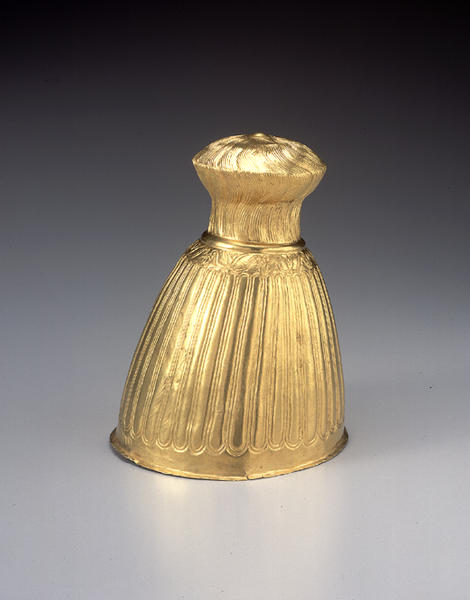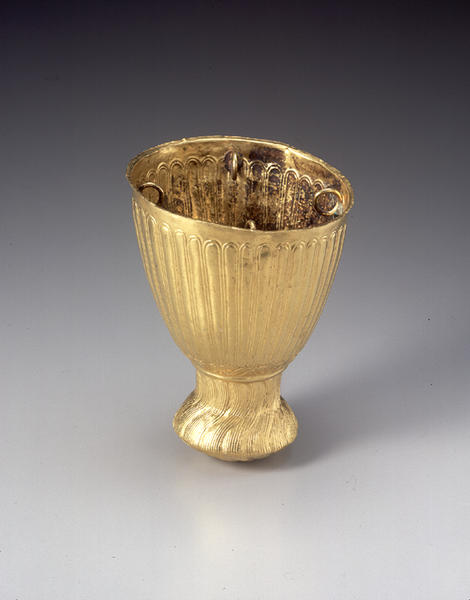Censer
- 5th - 4th century B.C.
- Gold
- H-9.8 D-7.6
Catalogue Entry
5th‐4th century B.C.
Gold
H. 9.8 cm, Dia. 7.6 cm
This high-footed cup form is thought to originally have been a censer. The foot with its rounded bottom is incised from the center of the base with a radiating pattern of thin lines which rise up the sides of the foot. This may have been designed to represent the rising smoke of the incense. The upper body of this censer is covered with a grooved pattern of long flower petals, and there is a rounded protruding band between vessel foot and body, an area also circled by a narrow band of lotus and palmette designs. The upper edge of the vessel rim is cut into a diagonal cut form, while the grooved pattern length differs depending on the shape of the vessel. Four equally spaced rings are attached to the interior point of attachment between body and rim, and these are thought to have been used to attach chains.
Vessels
The "vessels" division is represented by a relatively large number of objects.There are 22 items of gold (cat. Nos. 123-144) and 26 of silver (cat. Nos. 97-122). Among the silver vessels, there are 6 goblets (cat. Nos. 103-106, 108, 109) tall libation vessels Achaemenid in form, but decorated in a style which is typically Hellenistic. Similar cups are held by the magi represented on the relief sculptures and votive plaques. Three rhyta made for a similar purpose are unfortunately in a fragmentary condition (cat. Nos. 118, 119, 122). In addition there are 8 shallow bowls (cat. Nos. 97-99, 101, 102, 111-113) for ritual libations. The gold vessels were used for the same purpose; there are 18 libation bowls, of simple form, most of which have a rounded base and everted rim (cat. Nos. 123-140). One tall vessel of a pyxis type with a lid (cat. No. 142) appears to be the earliest of the vessels in the collection. Of special interest is an incense burner in the form of a censer with four rings for suspension (cat. No. 141).
Although the number of vessels in this collection is considerably larger than those of the Oxus Treasure in the British Museum, they probably served the same function. The vessels of both collections are closely paralleled by the vessels held by worshippers depicted on the Persepolis reliefs. This observation makes it possible to date them. It is worth adding here that the manufacture of goblets of similar shape and of rhyta in the Persepolitan style is depicted on a relief in a pronaos on the northern wall of the tomb of Petosiris at Hermopolis Magna in Egypt. According to Muscarella, the reliefs attest the manufacture of embossed articles in Egypt right up until 300 BC.
Rhyton with a Stag
Shallow Bowl with a Rosette Pattern
Shallow Bowl with a Rosette Pattern
Phiale with a Rosette Pattern
Bowl with a Rosette Pattern
Phiale
Fragment of a Shallow Bowl
Bowl with a Rosette Pattern
Bowl with a Rosette Pattern
Bowl with a Rosette Pattern
Bowl with a Rosette Pattern
Bowl with a Lotus and PalmettePattern
Bowl with a Rosette Pattern
Bowl with a Human Heads Decoration
Bowl with a Rosette Pattern
Shallow Bowl with a Leaf
Plate with Ketos
Bowl
Kotyle with Mythical Figures
Situla with a Lion's Head
Rhyton with a horse protome
Horse (Fragment of a rhyton)
Winged Human-headed Bull(Fragment of a rhyton)
Decoration of a Ladle
Disk-like Round Mirror
Lion Griffin (Fragment of a Rhyton)
Shallow Bowl with a Rosette Pattern
Sallow Bowl
Sallow Bowl
Bowl
Sallow Bowl
Bowl
Bowl
Bowl
Bowl
Bowl
Bowl
Bowl
Bowl
Bowl
Bowl
Bowl
Bowl
Bowl
Bowl with Lid

